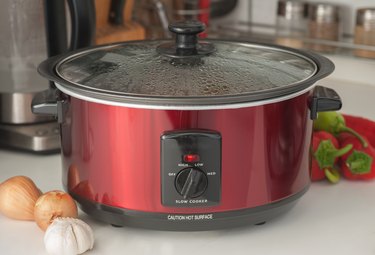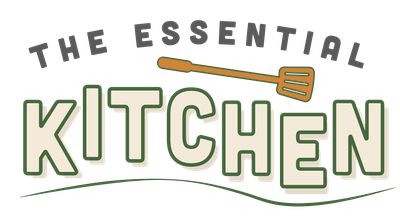
If you're looking to boost your cooking skills, chances are you may have started to get a little creative with that slow cooker sitting in the basement. After all, this popular kitchen appliance can whip up large batches of meals that provide leftovers for days.
"Slow cookers, such as the Crock-Pot, are amazing at making full meals without a lot of clean up," registered dietitian Monica Salafia, RD, CPT, tells us. "What's great is that you can combine all of your macronutrients into one meal, and have them all cook together. For example, you can combine sweet potatoes and beef (or chicken) with broccoli for a complete meal filled with carbohydrates, protein and fiber from the veggies."
Nutritional perks aside, Emmy-nominated chef Nathan Lyon suggests that this tool also boasts culinary benefits worth bragging about: Its set-it-and-forget-it appeal makes it attractive to those on a time crunch, or to those who want to save some counter space in the kitchen.
"A slow cooker is the ultimate one-pot-wonder device for anything in the stew, soup or braising category," Lyon says. "It makes cooking simple and easy — especially during those super hot days when you don't want to use a traditional oven."
To give slow cooker newbies a complete step-by-step breakdown on how a slow cooker works and some meal ideas to help you get through, we tapped chefs and registered dietitians to explain the ins-and-outs of using this appliance correctly. Read their advice ahead before you start meal prepping for the week.
How to Use a Slow Cooker
Although using a slow cooker may seem intimidating at first glance, it's actually a very simple process, celebrity chef and nutritionist Serena Poon, CN, reassures.
"All you need to do is prep your ingredients, place them into the slow cooker pot and turn it on," Poon says. "A slow cooker works by heating food from the bottom and then distributing the heat evenly throughout the vessel."
Follow Poon's foolproof instructions on how to use your slow cooker:
- Place longer-cooking foods on the bottom: Given that a slow cooker works by heating food from the bottom up, place foods that take longer to cook (like root vegetables including potatoes) at the bottom of the pot.
- Add proteins: Next, place your meats or proteins into the pot.
- Add liquid: Pour in your liquid of choice, such as water, broth, marinades or sauce.
- Check for the heat settings and turn it on: After you place all your ingredients in the pot, it's time to place the lid onto the pot, turn on the slow cooker and let it cook while you carry on with your day. Note that most slow cookers have two settings: a low heat setting for longer cook times and a high heat setting for shorter cook times. Choose the one your recipe calls for.
What to Know Before Using a Slow Cooker
Choose your recipes carefully: If your recipe calls for cooking ingredients on "low and slow," Pat Schweitzer, director of the Hamilton Beach Test Kitchen, says that a slow cooker can get the job done.
But if the recipe calls for using the oven, she advises forgoing using the slow cooker. Similarly, if your recipe calls for very high temperatures of oil to fry things quickly, a slow cooker may not work well.
Yes, you can burn food in a slow cooker: Although food is less likely to scorch inside a slow cooker, Schweitzer says it's still possible to overcook meats and vegetables if you aren't careful.
"Even if they're submerged in liquid, meats can lose moisture within the meat fibers — particularly quick-cooking meats like chicken breasts," she says.
"That is why slow cooking is best for the meats and vegetables that benefit from long cooking times." To avoid overcooking meals inside your slow cooker, Poon advises following recipe directions carefully and setting the appliance's timer to turn off at an exact time.
Can You Leave the Slow Cooker Unattended?
"It's generally safe to leave your slow cooker on and leave the house as long as you follow the safety precautions outlined in your appliance’s safety manual," Poon says.
Make sure to read the specific precautions for your appliance and follow these standards:
- Place your slow cooker on a flat, heat-resistant surface.
- Keep your slow cooker away from the wall.
- Keep your slow cooker away from heat sources and water.
- Do not under or overfill your slow cooker.
What to Cook in a Slow Cooker
Since slow cookers use low cooking temperatures and retain moisture during the cooking process, Schweitzer says it is great for many types of foods.
1. Meats
For starters, Schweitzer says meats are one of the best food items that can be cooked inside a slow cooker. Those less expensive and tougher cuts of meat (such as stews, beef and roasts) are tenderized nicely in slow cookers and can be used for a variety of different dishes.
However, Lyon advises braising large, tough meats such as pot roast and pulled pork for a longer period of time.
And yes, one of the major benefits of a slow cooker is that it tenderizes tougher meats and makes them flavorful, according to Poon. However, in order to ensure they can have ideal consistency, she recommends submerging the meat in liquid (water, stock or broth) to enhance the flavors.
2. Sauces, Soups and Dips
Unlike meats, Schweitzer suggests that some concoctions — such as marinara sauce and chicken soup — need time to develop flavors. Sauces and soups work well in a slow cooker that's set on low.
Party and appetizer dips and can be cooked on the slow cooker's high setting for only one to two hours, she adds.
3. Veggies
Vegetables can also be cooked inside a slow cooker, Schweitzer says, but you'll want to keep in mind that certain produce have longer cook times than others.
"Vegetables that work well with slow cookers are root vegetables, including potatoes and carrots as well as onions. They can be added with meats or poultry at the beginning of the cooking process," she explains.
"Vegetables that take a shorter time to cook — such as broccoli and zucchini — can be added toward the end of the cooking time." She recommends adding broccoli pieces to the slow cooker about 30 minutes before the cooking time ends.
Slow Cooker Recipes You'll Love
- 8 Deliciously Simple (and Healthy!) Slow Cooker Recipes
- 7 Healthy Vegetarian Slow Cooker Recipes From Chili to Moussaka
- 6 Mediterranean Diet Slow Cooker Recipes That'll Get Dinner on the Table Effortlessly
- 7 Balanced Slow-Cooker Dinners That Provide All 3 Macros in One Dish
- 6 Keto-Friendly Slow Cooker Recipes That Make Meals a Breeze
- 6 Things You Didn’t Know You Can Make in a Slow Cooker (But Should, Stat)
4 Things to Consider Before Buying a Slow Cooker
When it comes to purchasing a good slow cooker unit, it's important to consider a few factors before you actually order one online. These include size, shape and built-in features that ensure your meals are cooked safely at the right temperature.
1. Size
The size of your slow cooker is one of the most important things to keep in mind before you shop, as Schweitzer says you'll want to consider how much food you usually cook and how many people you cook for.
However, a good rule of thumb to remember is that smaller slow cooker sizes are better for one to two-serving size meals, according to Schweitzer. Smaller slow cookers can be used to serve warm dips and spreads at a party, she adds.
Medium-sized slow cookers (about four to six quarts), on the other hand, are great for families, as they can cook nutritious meals that will serve plenty. However, medium-sized appliances can also be a great meal-prep helper, as Schweitzer says they can be used to cook whole chickens for lots of leftovers for the days ahead.
The largest slow cookers (up to ten quarts), she adds, are great for feeding a crowd or for batch-cooking.
2. Shape
Since all slow cookers work the same way, the shape of your slow cooker (whether round or oval) is worth considering, according to Schweitzer.
No matter what kind of shape you choose, Schweitzer says that you'll always want to consider the number of people you are cooking for, and the amount of storage space in your kitchen
But if you're curious about the difference between round and oval-shaped slow cookers, Schweitzer explains that oval-shaped slow cookers are better for larger and more horizontally-shaped meats such as chickens, chuck or pot roasts. The taller, rounder slow cookers can be better for soups or stews.
3. Lid
Another important feature to look for in a slow cooker is a tight-fitting clear glass lid, according to Poon. A clear lid will allow you to keep tabs on the progress of your food without opening the lid (which can lengthen cooking time).
A loose-fitting lid can also increase the cooking time of your meal, or even ruin it altogether.
4. Programmable Features
You'll want to look out for a slow cooker with programmable settings, as these added tools give you more control over slow cooking and add a lot of other convenient benefits.
"Not only will your slow cooker do all the cooking for you, but you can also set it to cook for a set amount of time, making it easier for you to leave the house while it's cooking," Schweitzer explains.
One of the best features to look out for is automatic shutoff, as some of the older pots don't have this safety feature. This ensures that you can cook meals safely and without overcooking them.
Another perk: Slow cookers typically use less energy than other appliances, deeming it efficient for both you and your home, according to Schweitzer. "A small slow cooker uses approximately the same power as one and a half 100-watt light bulbs," she says. "Because it cooks with contained heat, it uses less energy."
Looking to Buy a Slow Cooker?
Check out our guide to The Best Slow Cookers for Every Household Size, Personality Type and Budget.
